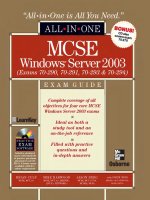Tài liệu Beginning SQL Server Modeling- P1 pptx
Bạn đang xem bản rút gọn của tài liệu. Xem và tải ngay bản đầy đủ của tài liệu tại đây (984.65 KB, 20 trang )
C H A P T E R 1
1
Installing and Setting Up
SQL Server Modeling
This chapter will walk you through the procedures of downloading, installing,
repairing, and uninstalling SQL Server Modeling, as well as what’s required for
getting software pre-requisites in place. These pre-requisite applications should, of
course, be up and running before you install SQL Server Modeling. I will take this
step by step, and if you follow the procedures outlined in this chapter, you should
have a working installation of SQL Server Modeling by the time you finish.
But before downloading or installing anything, take a look at the current
version of the SQL Server Modeling release notes. As of this writing, these can be
found at the following MSDN URL:
The release notes provide links for downloading the SQL Server Modeling setup file as well as links
for downloading the software pre-requisites listed in the next section. They also provide important
information affecting how you should go about installing SQL Server Modeling and what needs to be in
place for a successful setup. Once you have run the setup file, there should be a Readme file installed
under Program Files/Microsoft Oslo/1.0 /Readme.htm. (This is the installation path for the CTP R3
release. The path may be different for subsequent releases.) The Readme file provides much of the same
information as that provided in the release notes and can be viewed by loading it in your web browser
using the browser’s File
Open menu.
The procedures that follow are based on the November, 2009 CTP Release 3. (CTP is the acronym for
Community Technology Preview.)
Software Pre-Requisites
Several software systems must be in place before you begin the actual installation of SQL Server
Modeling:
• Windows Installer 4.5 or later (search for “Windows Installer 4.5 Redistributable”
on www.Micorosoft.com ]
• To run setup, Windows Installer 4.5 is required.
• If Windows Installer is not installed, a system restart will be requested after
its installation completes.
Download from Wow! eBook <www.wowebook.com>
CHAPTER 1 INSTALLING AND SETTING UP SQL SERVER MODELING
2
• .NET Framework 4
• SQL Server 2008 SP1 Express (or higher edition)
• Visual Studio 2010 (any edition): Visual Studio is not required for SQL Server
Modeling CTP Release 3, but for full functionality with Visual Studio and M Tools
integration, Visual Studio 2010, Visual C#, and Visual Web Developer are required.
Hardware and Operating System Requirements
SQL Server Modeling must be installed on a computer with any combination of the following CPU
architecture and operating systems. Note the SP (Service Pack) for some of the listed operating systems.
If the Service Pack listed is not installed, it should be downloaded and installed before proceeding.
Supported CPU Architectures:
• X86
• X64 (Windows-on-Windows)
Hardware Requirements:
• Minimum: 1.6 GHz CPU, 1GB RAM
• Recommended: 2.2 GHz CPU, 2GB RAM
Supported Operating Systems:
• Windows XP SP3 or later
• Windows Vista (SP1, SP2, or later)
• Windows Server 2003 R2 (SP2 or later)
• Windows Server 2008 SP2
• Windows 7
Configuring SQL Server
Before running the installation executable, be sure SQL
Server is running. Bring up the SQL Server
Configuration Manager as shown in Figure 1-1. Here’s the sequence for bringing up this tool:
1. Click the Start button on your Windows Taskbar.
2. Click All Programs.
3. Go to Microsoft SQL Server 2008 (if, for example, you are running the 2008
SKU).
4. Click Configuration Tools.
Download from Wow! eBook <www.wowebook.com>
CHAPTER 1 INSTALLING AND SETTING UP SQL SERVER MODELING
3
5. Click SQL Server Configuration Manager.
Figure 1-1. Opening the SQL Server Configuration Manager
Once you have the Configuration Manager running, navigate to Configuration Tools, then to SQL
Native Client XX.X Configuration/Client Protocols, (where XX.X will correspond to the version number of
your SQL Server installation, such as 10.0), as shown in Figure 1-2. Which client protocols are enabled
will depend on whether the database is running on the same computer on which you’re installing SQL
Server Modeling, or remotely. If it’s running on your local machine, all you should need is the Shared
Memory protocol. If it’s running on a server on your network, Named Pipes and/or TCP/IP should be
enabled.
It doesn’t hurt to have Shared Memory, Named Pipes, and TCP/IP all enabled, but their specified
order may affect performance. If SQL Server is running on a local server, your network administrator
should be able to tell you whether TCP/IP or Named Pipes will provide better performance. On most
large networks, TCP/IP would be the preferred protocol.
VIA (Virtual Interface Adapter) would normally be disabled unless your hardware environment
supports this protocol, in which case the other protocols can be disabled. The order can be changed in
the Configuration Manager by right-clicking in the right frame on any of the enabled protocols. You will
see a popup menu where Order will be one of the possible selections.
Figure 1-2. Setting the SQL native client protocols
Download from Wow! eBook <www.wowebook.com>
Download from Wow! eBook
<www.wowebook.com>
CHAPTER 1 INSTALLING AND SETTING UP SQL SERVER MODELING
4
Downloading and Installing
Once the software pre-requisites previously listed are in place, you’re ready to download the SQL Server
Modeling installation file from the SQL Server Modeling download website. The file size is around 40
MB, so it can take a few minutes if you have a slow Internet connection. After it has downloaded, you
should be able to open it in your browser’s download facility. Another option would be to open Windows
Explorer and navigate to the folder where you have saved the downloaded file. Open the file by right-
clicking on the filename and then clicking the Open option. You may see a security warning like the one
shown in Figure 1-3.
Figure 1-3. Open File – Security Warning dialog when running the installation file
Click the Run button to start the installation process. The next dialog window to appear (shown in
Figure 1-4) will be the initial SQL Server Modeling installation window. This gives you two choices:
Install Now or Customize. If you are running the SQL Server Modeling install for the first time, click the
Install Now option.
Figure 1-4. SQL Server Modeling initial installation window
After clicking Install Now, you should next see the Usage Reporting window, as shown in Figure 1-5.
Download from Wow! eBook <www.wowebook.com>
CHAPTER 1 INSTALLING AND SETTING UP SQL SERVER MODELING
5
Figure 1-5. Usage Reporting window
Check or uncheck the box, according to whether you would like to participate in the Customer
Experience Improvement Program, then click the Continue button.
The next step is to accept the End User License Agreement (shown in Figure 1-6). Read the
agreement and (if you agree) click the I Accept button.
Figure 1-6. Accepting the End User License Agreement
This will start the third step in the installation process, which should present the Installation
Progress window similar to the one shown in Figure 1-7.
Download from Wow! eBook <www.wowebook.com>
CHAPTER 1 INSTALLING AND SETTING UP SQL SERVER MODELING
6
Figure 1-7. Step 3: Installing SQL Server Modeling Services, Quadrant, and other components
This portion of the installation process can take ten minutes or more, depending on your
computer’s speed. Once this part of the installation has completed, the process will move on to the
fourth and final step, which configures and deploys the Repository to SQL Server (see Figure 1-8). Again,
this may take several minutes to complete.
Figure 1-8. Step 4: Configuration and deployment
Once step 4 has completed, you should see a window similar to that shown in Figure 1-9, notifying
you that setup has completed successfully.
Download from Wow! eBook <www.wowebook.com>
CHAPTER 1 INSTALLING AND SETTING UP SQL SERVER MODELING
7
Figure 1-9. Successful setup completion
At this point, simply click on the close button to finish the installation.
Checking the Installation
After the installation is completed, click the Start button on the Windows Taskbar, then click All
Programs to see if the Microsoft SQL Server Modeling CTP program group appears in the All Programs
list. If you click on this program group, you should see Intellipad, Quadrant, and other options listed, as
shown in Figure 1-10. The order of the items may not be the same as shown in the figure, but you can
rearrange the items by clicking and dragging each to the position you want.
Figure 1-10. The SQL Server Modeling CTP program group
If you don’t see the Microsoft SQL Server Modeling CTP group in the All Programs list, go to the
Windows Control Panel, bring up Add or Remove Programs, and check to see if it appears in the list of
installed programs. Make sure the list is sorted by name, then scroll down in the list to the Microsoft
programs. You should see the SQL Server Modeling CTP application listed, as shown in Figure 1-11.
Download from Wow! eBook <www.wowebook.com>
CHAPTER 1 INSTALLING AND SETTING UP SQL SERVER MODELING
8
Figure 1-11. SQL Server Modeling CTP listed in Add or Remove Programs
In the Start button All Programs list, double-click on Intellipad. As it is loading, the Intellipad
“splash screen” should display more or less as it appears in Figure 1-12.
Figure 1-12. Intellipad splash screen
Bring up Quadrant and each of the other three options in turn, just to familiarize yourself with them.
I recommend taking a close look at the Readme file, which has some tips on troubleshooting in case you
run into problems, as well as links to other resources, including release notes and the online Help page.
It’s good to keep these resources in mind as you start working with the software, in case any issues or
questions should come up.
If Something Goes Wrong…
If you run into problems with the installation, there are several things you can do:
1. The Readme file includes a troubleshooting section that discusses what to do if
you run into several different kinds of problems.
2. The release notes list a number of breaking changes and known issues in
detail. If you don’t find what you need in the Readme file, you may find some
useful tips in the release notes. The Readme file provides a link to online
release notes.
3. You can run the Repair option by clicking the Change/Remove button in the
Add or Remove Programs section of the Control Panel (refer to Figure 1-11).
This option is discussed briefly in the following section.
4. You can uninstall and then re-install with the hope of resolving the problem on
the second go-around.
Download from Wow! eBook <www.wowebook.com>









